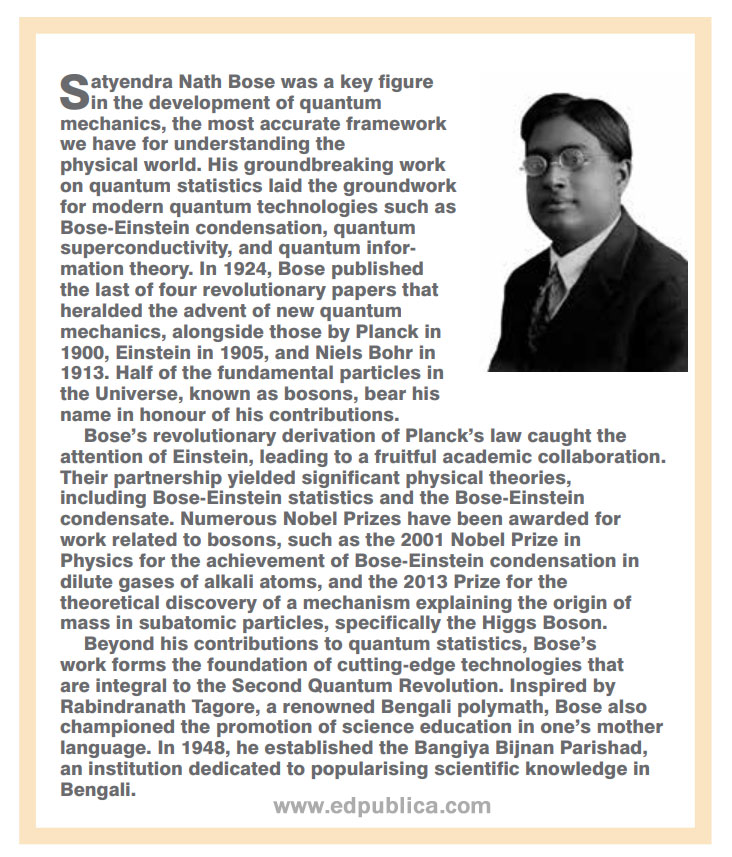Space & Physics
The Story of the World’s Most Underrated Quantum Maestro
As the world celebrates the 131st birth anniversary of S.N. Bose, EdPublica explores the theoretical physicist’s unparalleled contributions to the field of quantum mechanics

It’s 1924, and Satyendra Nath Bose, going by S.N. Bose was a young physicist teaching in Dhaka, then British India. Grappled by an epiphany, he was desperate to have his solution, fixing a logical inconsistency in Planck’s radiation law, get published. He had his eyes on the British Philosophical Magazine, since word could spread to the leading physicists of the time, most if not all in Europe. But the paper was rejected without any explanations offered.
But he wasn’t going to give up just yet. Unrelenting, he sent another sealed envelope with his draft and this time a cover letter again, to Europe. One can imagine months later, Bose breathing out a sigh of relief when he finally got a positive response – from none other than the great man of physics himself – Albert Einstein.
In some ways, Bose and Einstein were similar. Both had no PhDs when they wrote their treatises that brought them into limelight. And Einstein introduced E=mc2 derived from special relativity with little fanfare, so did Bose who didn’t secure a publisher with his groundbreaking work that invented quantum statistics. He produced a novel derivation of the Planck radiation law, from the first principles of quantum theory.

This was a well-known problem that had plagued physicists since Max Planck, the father of quantum physics himself. Einstein himself had struggled time and again, to only have never resolved the problem. But Bose did, and too nonchalantly with a simple derivation from first principles grounded in quantum theory. For those who know some quantum theory, I’m referring to Bose’s profound recognition that the Maxwell-Boltzmann distribution that holds true for ideal gasses, fails for quantum particles. A technical treatment of the problem would reveal that photons, that are particles of light with the same energy and polarization, are indistinguishable from each other, as a result of the Pauli exclusion principle and Heisenberg’s uncertainty principle.
Fascinatingly, last July marked the 100 years since Einstein submitted Bose’s paper, “Planck’s law and the quantum hypothesis” on his behalf to Zeitschrift fur Physik.
Fascinated and moved by what he read, Einstein was magnanimous enough to have Bose’s paper translated in German and published in the journal, Zeitschrift für Physik in Germany the same year. It would be the beginning of a brief, but productive professional collaboration between the two theoretical physicists, that would just open the doors to the quantum world much wider. Fascinatingly, last July marked the 100 years since Einstein submitted Bose’s paper, “Planck’s law and the quantum hypothesis” on his behalf to Zeitschrift fur Physik.
With the benefit of hindsight, Bose’s work was really nothing short of revolutionary for its time. However, a Nobel Committee member, the Swedish Oskar Klein – and theoretical physicist of repute – deemed it a mere advance in applied sciences, rather than a major conceptual advance. With hindsight again, it’s a known fact that Nobel Prizes are handed in for quantum jumps in technical advancements more than ever before. In fact, the 2001 Nobel Prize in Physics went to Carl Wieman, Eric Allin Cornell, and Wolfgang Ketterle for synthesizing the Bose-Einstein condensate, a prediction made actually by Einstein based on Bose’s new statistics. These condensates are created when atoms are cooled to near absolute zero temperature, thus attaining the quantum ground state. Atoms at this state possess some residual energy, or zero-point energy, marking a macroscopic phase transition much like a fourth state of matter in its own right.
Such were the changing times that Bose’s work received much attention gradually. To Bose himself, he was fine without a Nobel, saying, “I have got all the recognition I deserve”. A modest character and gentleman, he resonates a lot with the mental image of a scientist who’s a servant to the scientific discipline itself.
He was awarded the Padma Vibhushan, the highest civilian award by the Government of India in 1954. Institutes have been named in his honour, but despite this, his reputation has little if no mention at all in public discourse.
But what’s more upsetting is that, Bose is still a bit of a stranger in India, where he was born and lived. He studied physics at the Presidency College, Calcutta under the tutelage that saw other great Indian physicists, including Jagdish Chandra Bose and Meghnad Saha. He was awarded the Padma Vibhushan, the highest civilian award by the Government of India in 1954. Institutes have been named in his honour, but despite this, his reputation has little if no mention at all in public discourse.

To his physicists’ peers in his generation and beyond, he was recognized in scientific lexicology. Paul Dirac, the British physicist coined the name ‘bosons’ in Bose’s honor (‘bose-on’). These refer to quantum particles including photons and others with integer quantum spins, a formulation that arose only because of Bose’s invention of quantum statistics. In fact, the media popular, ‘god particle’, the Higgs boson, carries a bit of Bose as much as it does of Peter Higgs who shared the 2013 Nobel Prize in Physics with Francois Euglert for producing the hypothesis.
Space & Physics
New double-slit experiment proves Einstein’s predictions were off the mark
Results from an idealized version of the Young double-slit experiment has upheld key predictions from quantum theory.

- MIT physicists perform the most idealized double-slit experiment to date, using individual atoms as slits.
- Experiment confirms the quantum duality of light: light behaves as both a particle and a wave, but both behaviors can’t be observed simultaneously.
- Findings disprove Albert Einstein’s century-old prediction regarding detecting a photon’s path alongside its wave nature.
In a study published in Physical Reviews Letters on July 22, researchers at MIT have realized an idealized version of the famous double-slit experiment in quantum physics yet.
The double-slit experiment—first devised in 1801 by the British physicist Thomas Young—remains a perplexing aspect of reality. Light waves passing through two slits, form interference patterns on a wall placed behind. But this phenomenon is at odds with the fact light also behaves as particles. The contradiction has lent itself to a paradox, which sits at the foundation of quantum mechanics. It has sparked a historic scientific duel nearly a century ago, between physics heavyweights Albert Einstein and Niels Bohr. The study’s findings have now settled the decades-old debate, showing Einstein’s predictions were off the mark.
Einstein had suggested that by detecting the force exerted when a photon passes through a slit—a nudge akin to a bird brushing past a leaf—scientists could witness both light’s wave and particle properties at once. Bohr countered with the argument that observing a photon’s path would inevitably erase its wave-like interference pattern, a tenet since embraced by quantum theory.
The MIT team stripped the experiment to its purest quantum elements. Using arrays of ultracold atoms as their slits and weak light beams to ensure only one photon scattered per atom, they tuned the quantum states of each atom to control the information gained about a photon’s journey. Every increase in “which-path” information reduced the visibility of the light’s interference pattern, flawlessly matching quantum theory and further debunking Einstein’s proposal.
“Einstein and Bohr would have never thought that this is possible, to perform such an experiment with single atoms and single photons,” study senior author and Nobel laureate, Wolfgang Ketterle, stated in a press release. “What we have done is an idealized Gedanken (thought) experiment.”
In a particularly stunning twist, Ketterle’s group also disproved the necessity of a physical “spring”—a fixture in Einstein’s original analogy—by holding their atomic lattice not with springs, but with light. When they briefly released the atoms, effectively making the slits “float” in space, the same quantum results persisted. “In many descriptions, the springs play a major role. But we show, no, the springs do not matter here; what matters is only the fuzziness of the atoms,” commented MIT researcher Vitaly Fedoseev in a media statement. “Therefore, one has to use a more profound description, which uses quantum correlations between photons and atoms.”
The paper arrives as the world prepares for 2025’s International Year of Quantum Science and Technology — marking 100 years since the birth of quantum mechanics. Yoo Kyung Lee, a fellow co-author, noted in a media statement, “It’s a wonderful coincidence that we could help clarify this historic controversy in the same year we celebrate quantum physics.”
Space & Physics
Researchers Uncover New Way to Measure Hidden Quantum Interactions in Materials

A team of MIT scientists has developed a theory-guided strategy to directly measure an elusive quantum property in semiconductors — the electron-phonon interaction — using an often-ignored effect in neutron scattering.
Their approach, published this week in Materials Today Physics, reinterprets an interference effect, typically considered a nuisance in experiments, as a valuable signal. This enables researchers to probe electron-phonon interactions — a key factor influencing a material’s thermal, electrical, and optical behaviour — which until now have been extremely difficult to measure directly.
“Rather than discovering new spectroscopy techniques by pure accident, we can use theory to justify and inform the design of our experiments and our physical equipment,” said Mingda Li, senior author and associate professor at MIT, in a media statement.
By engineering the interference between nuclear and magnetic interactions during neutron scattering, the team demonstrated that the resulting signal is directly proportional to the electron-phonon coupling strength.
“Being able to directly measure the electron-phonon interaction opens the door to many new possibilities,” said MIT graduate student Artittaya Boonkird.
While the current setup produced a weak signal, the findings lay the groundwork for next-generation experiments at more powerful facilities like Oak Ridge National Laboratory’s proposed Second Target Station. The team sees this as a shift in materials science — using theoretical insights to unlock previously “invisible” properties for a range of advanced technologies, from quantum computing to medical devices.
Space & Physics
Dormant Black Holes Revealed in Dusty Galaxies Through Star-Shredding Events

In a major discovery, astronomers at MIT, Columbia University, and other institutions have used NASA’s James Webb Space Telescope (JWST) to uncover hidden black holes in dusty galaxies that violently “wake up” only when an unsuspecting star wanders too close.
The new study, published in Astrophysical Journal Letters, marks the first time JWST has captured clear signatures of tidal disruption events (TDEs) — catastrophic episodes where a star is torn apart by a galaxy’s central black hole, emitting a dramatic burst of energy.
“These are the first JWST observations of tidal disruption events, and they look nothing like what we’ve ever seen before,” said lead author Megan Masterson, a graduate student at MIT’s Kavli Institute for Astrophysics and Space Research. “We’ve learned these are indeed powered by black hole accretion, and they don’t look like environments around normal active black holes.”
Until now, nearly all TDEs detected since the 1990s were found in relatively dust-free galaxies using X-ray or optical telescopes. However, researchers suspected many more events remained hidden behind thick clouds of galactic dust. JWST’s powerful infrared vision has finally confirmed their hunch.
By analyzing four galaxies previously flagged as likely TDE candidates, the team detected distinct infrared fingerprints of black hole accretion — the process of material spiraling into a black hole, producing intense radiation. These signatures, invisible to optical telescopes, revealed that all four events stemmed not from persistently active black holes but dormant ones, roused only when a passing star came too close.
“There’s nothing else in the universe that can excite this gas to these energies, except for black hole accretion,” Masterson noted.
Among the four signals studied was the closest TDE ever detected, located 130 million light-years away. Another showed an initial optical flash that scientists had earlier suspected to be a supernova. JWST’s readings helped clarify the true cause.
“These four signals were as close as we could get to a sure thing,” said Masterson. “But the JWST data helped us say definitively these are bonafide TDEs.”
To determine whether the central black holes were inherently active or momentarily triggered by a star’s disruption, the team also mapped the dust patterns around them. Unlike the thick, donut-shaped clouds typical of active galaxies, these dusty environments appeared markedly different — further confirming the black holes were usually dormant.
“Together, these observations say the only thing these flares could be are TDEs,” Masterson said in a media statement.
The findings not only validate JWST’s unprecedented ability to study hidden cosmic phenomena but also open new pathways for understanding black holes that lurk quietly in dusty galactic centers — until they strike.
With future observations planned using JWST, NEOWISE, and other infrared tools, the team hopes to catalog many more such events. These cosmic feeding frenzies, they say, could unlock key clues about black hole mass, spin, and the very nature of their environments.
“The actual process of a black hole gobbling down all that stellar material takes a long time,” Masterson added. “And hopefully we can start to probe how long that process takes and what that environment looks like. No one knows because we just started discovering and studying these events.”
-

 Society5 months ago
Society5 months agoStarliner crew challenge rhetoric, says they were never “stranded”
-

 Space & Physics4 months ago
Space & Physics4 months agoCould dark energy be a trick played by time?
-

 Earth5 months ago
Earth5 months agoHow IIT Kanpur is Paving the Way for a Solar-Powered Future in India’s Energy Transition
-

 Space & Physics4 months ago
Space & Physics4 months agoSunita Williams aged less in space due to time dilation
-

 Women In Science4 months ago
Women In Science4 months agoNeena Gupta: Shaping the Future of Algebraic Geometry
-

 Learning & Teaching5 months ago
Learning & Teaching5 months agoCanine Cognitive Abilities: Memory, Intelligence, and Human Interaction
-

 Society6 months ago
Society6 months agoSustainable Farming: The Microgreens Model from Kerala, South India
-

 Earth3 months ago
Earth3 months ago122 Forests, 3.2 Million Trees: How One Man Built the World’s Largest Miyawaki Forest






















